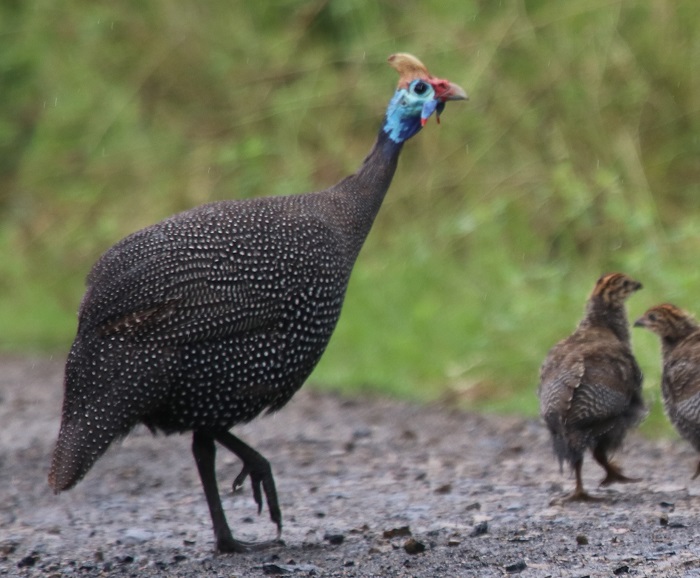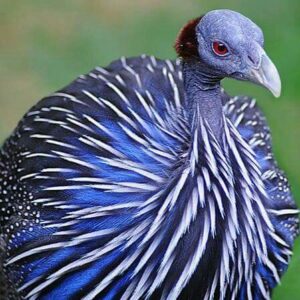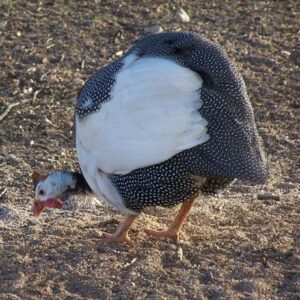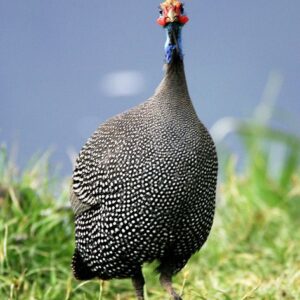The Helmeted Guinea Fowl (Numida meleagris) is a striking and distinctive bird native to sub-Saharan Africa, known for its unique appearance and social behavior. This medium-sized, ground-dwelling species is part of the family Numididae, and it is often recognized for its speckled plumage and bare head, which gives it a somewhat comical yet endearing look.
Physical Appearance: The Helmeted Guinea Fowl has a round body, typically ranging from 40 to 60 cm (16 to 24 inches) in length, and weighs between 1.5 to 2 kg (3.3 to 4.4 lbs). Its plumage is a mottled dark gray or bluish-black with distinctive white spots, giving it a speckled look that is quite eye-catching. One of the most notable features of the Helmeted Guinea Fowl is its bare, brightly colored head, which is adorned with a fleshy, helmet-like casque that sits on top of its head, hence the name “helmeted.” The face is generally red, with a blue skin area around the eyes and neck. This bird’s skin and casque coloration can vary slightly based on the individual and geographical location. The casque, while visually striking, is not believed to have any significant function other than to enhance its visual appeal during mating displays.
Habitat and Distribution: Helmeted Guinea Fowls are native to a wide range of environments in sub-Saharan Africa, including savannas, grasslands, open woodlands, and agricultural lands. They are highly adaptable, often seen in both natural habitats and farmlands, where they have also been domesticated for their meat and eggs. The species is distributed across much of sub-Saharan Africa, from Senegal in the west to Ethiopia in the east, and down to South Africa in the south. The bird is a non-migratory species, usually remaining in its home range throughout the year unless forced to move due to seasonal conditions or the availability of food.
Behavior and Social Structure: Helmeted Guinea Fowls are social birds, often found in flocks of up to 20 individuals, though larger groups are not uncommon. These birds tend to stay together for protection, foraging in groups and using vocalizations to communicate with one another. They are known for their loud, harsh calls that can be heard over long distances. These calls are used to warn the group of potential predators, to establish territory, and to maintain contact with other members of the flock.
Unlike many other birds, Helmeted Guinea Fowls are primarily ground-dwelling and forage on the ground for food, such as seeds, insects, small reptiles, and plants. They are particularly known for eating insects, including locusts and beetles, which helps make them valuable in controlling pests in agricultural areas.
Reproduction: The breeding season for Helmeted Guinea Fowl typically coincides with the rainy season when food is abundant. The male performs a courtship display to attract a mate, which often includes calling loudly and puffing up his feathers. Once a female has been attracted, she builds a nest on the ground, usually hidden in dense grass or shrubs. The nest is lined with grass, and the female lays a clutch of about 6 to 12 eggs, which she incubates for around 24 to 28 days. Both the male and female take turns guarding the nest, and once the eggs hatch, the young chicks are precocial (born with their eyes open and able to walk shortly after hatching). The parents protect and care for the chicks until they are old enough to join the group in foraging.
Domestication and Use: Helmeted Guinea Fowl have been domesticated in various parts of Africa, as well as in other regions of the world. Their meat is highly valued for its lean texture and gamey flavor, often described as a cross between chicken and turkey. In addition to their meat, guinea fowl eggs are also sought after, though they are smaller than chicken eggs. Due to their hardiness and ability to adapt to different environments, domesticated Helmeted Guinea Fowls are relatively easy to raise, and they are often kept for their egg production, as well as for their pest-controlling behavior.
Conservation Status: The Helmeted Guinea Fowl is currently listed as Least Concern on the International Union for Conservation of Nature (IUCN) Red List, as it has a large and stable population across its range. However, localized threats such as habitat destruction, hunting, and domestic trade could affect specific populations. Conservation efforts are focused more on the management of its habitat and sustainable farming practices, particularly in areas where they are domesticated.
In conclusion, the Helmeted Guinea Fowl is a fascinating bird known for its striking appearance, social behavior, and adaptability to a range of environments. Whether observed in the wild or in domesticated settings, it remains an important species both ecologically and economically in regions where it thrives.










Reviews
There are no reviews yet.